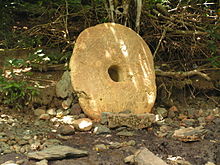Rai (currency)
Rai , also known as stone money , is a medium of exchange or pre-coinage used on the Ulithi Atoll in Yap , a federal state of the Federated States of Micronesia , and is still considered a means of payment, although production was discontinued in 1931 .
It consists of stone slices that are everywhere on the islands by the wayside or around the houses. When Rai changes hands, the new owner usually leaves the stone where it is due to its weight and the difficulties it brings with it. Who owns which stone is simply recorded in the memory.
Texture and manufacture
The stones can be as large as the palm of your hand up to 4 meters in diameter and weigh over 5 tons. They preferably consist of the minerals aragonite and calcite , which however do not occur on the island. So the stones had to be procured from Palau , which is about 400 kilometers southwest of Yap. This distance was covered with outrigger boats in a five-day journey.
A hole was made through the stones so that they could be transported to the sea with the help of sticks. Here they were loaded onto bamboo rafts or canoes. Particularly large stones were placed in the sea and the raft built around them. In a Japanese census in 1929, 13,281 pieces of stone money were documented, of which about half have survived to this day.
use

The stone money was used exclusively by men. Today the money is rarely used, mainly in symbolic deals. For example, when land is "sold", only the rights of use change, since land on Yap has no owner. The stone usually remains unmoved and only the owner changes. The local village elders are aware of the property rights to the panes.
According to tradition, the stone money must always be kept standing on the edge (i.e. leaning against trees, houses, etc.). It is considered a serious insult and is forbidden by law on Yap to sit on the stone discs or to otherwise misuse them (e.g. as a picnic table). Tourists can also be fined for this (which, however, have to be paid to the treasury in dollar bills), plus the bad looks of the locals.
value
The laborious production and the long transport from Palau to Yap limited the number and size of the stones and increased their value. Among other things, land could be acquired with them.
In the last few centuries there has been an inflation in stone money as the transportation of the stones became safe and cheap. The turning point was the founding of the company in 1875 by David Dean O'Keefe. He founded trading stations where he exchanged copra for a crossing to Palau. He sold the copra on to Hong Kong , and by the time he died in 1901, he earned about half a million dollars. Since then there have been very large stones on Yap with little prestige and the material value of the stone money is no longer available.
The story of O'Keefe was filmed in 1954 with the title "His Majesty O'Keefe". Burt Lancaster played as Capt. David O'Keefe starred.
Creation of value
The value results from various factors such as:
- size
- natural beauty
- shape
- History of the "coin"
- Age
- how difficult it was to make
- whether someone was in danger or died during transport
- social position of those involved
literature
- Thomas Lautz: Steinreich in the South Seas. Traditional means of payment in Micronesia. Third special volume by EUCOPRIMO (European Union to Search for, Collect and Preserve Primitive and Curious Money). Cologne 1999.



